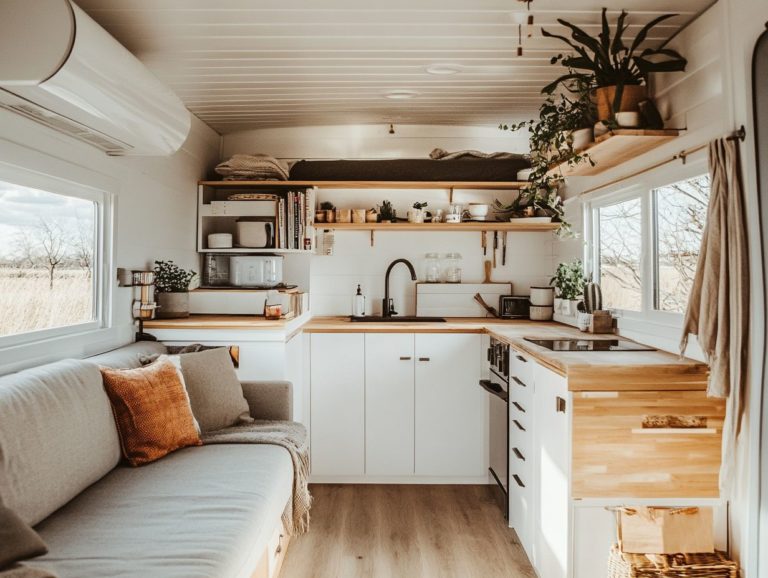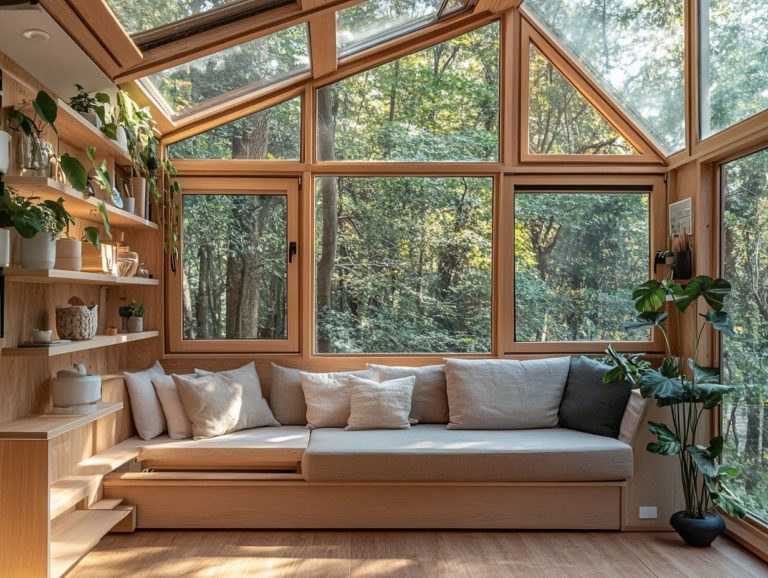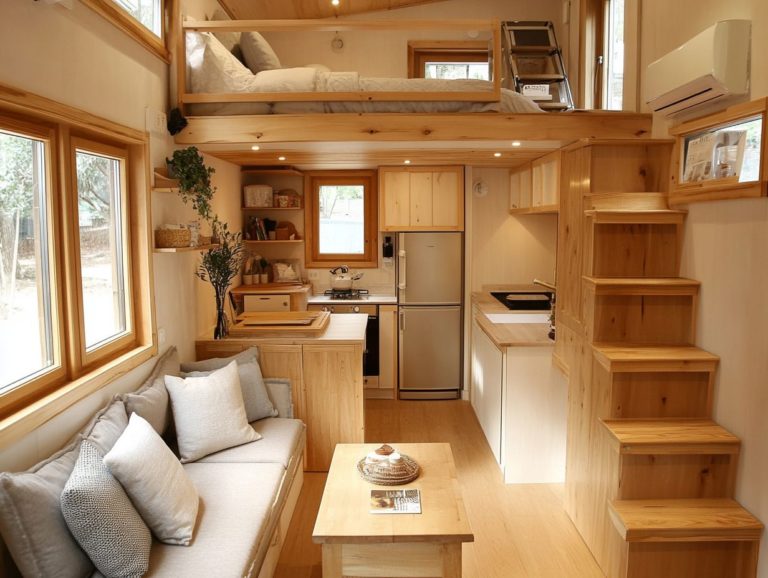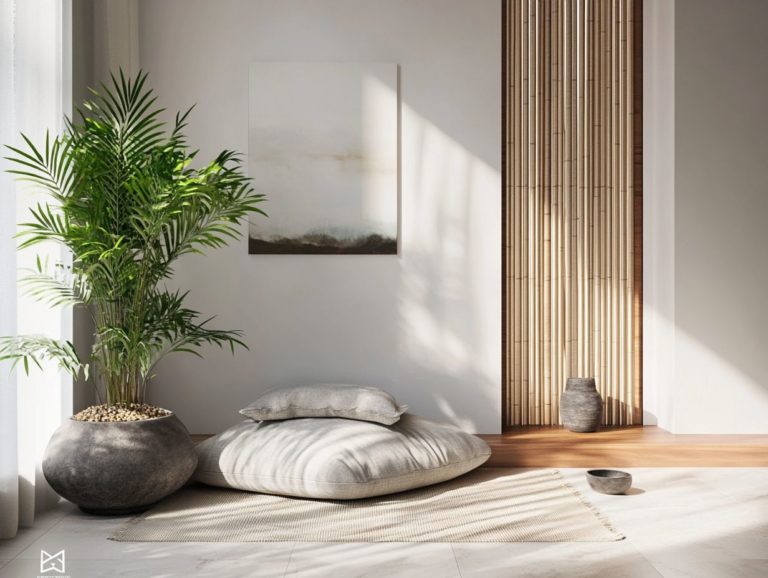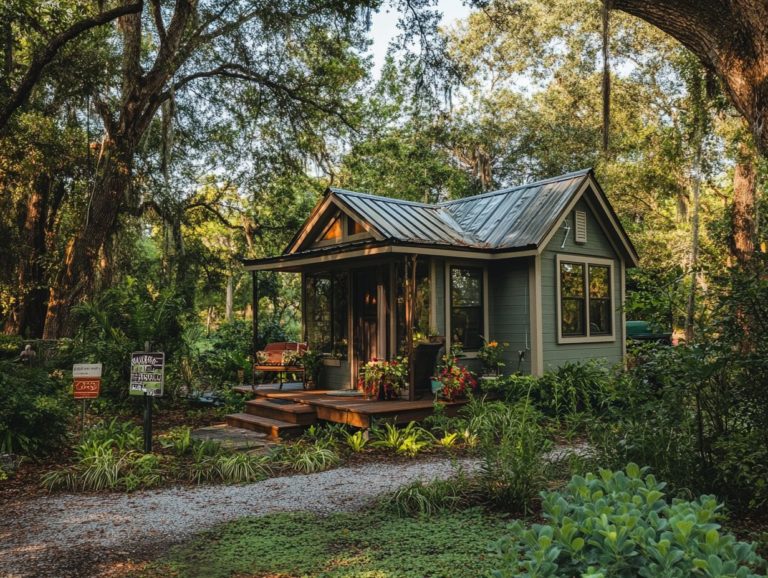How to Embrace Vertical Gardening in Tiny Homes
In a world where urban living frequently demands a trade-off of green space, vertical gardening presents an invigorating solution for those residing in compact homes.
This guide delves into the advantages and challenges of cultivating a vertical garden, walking you through plant selection, innovative design ideas, and the essential tools required to flourish in limited spaces. You will discover everything you need to transform your small home into a vibrant, green sanctuary.
Embrace the vertical gardening trend and discover how to optimize your living space while relishing the beauty and benefits of nature.
Contents [hide]
- Key Takeaways:
- Choosing the Right Plants for Vertical Gardening
- Designing a Vertical Garden for Your Tiny Home
- Materials and Tools Needed for Vertical Gardening
- Tips for Maintaining a Vertical Garden in a Tiny Home
- Maximizing Space for Vertical Gardening in Tiny Homes
- Frequently Asked Questions
- What is vertical gardening and how can it be incorporated into tiny homes?
- What are the benefits of embracing vertical gardening in tiny homes?
- What types of plants are best suited for vertical gardening in tiny homes?
- Do I need any special equipment to start vertical gardening in my tiny home?
- How can I ensure my vertical garden in my tiny home is successful?
- Are there any specific tips for maintaining a vertical garden in a tiny home?
Key Takeaways:
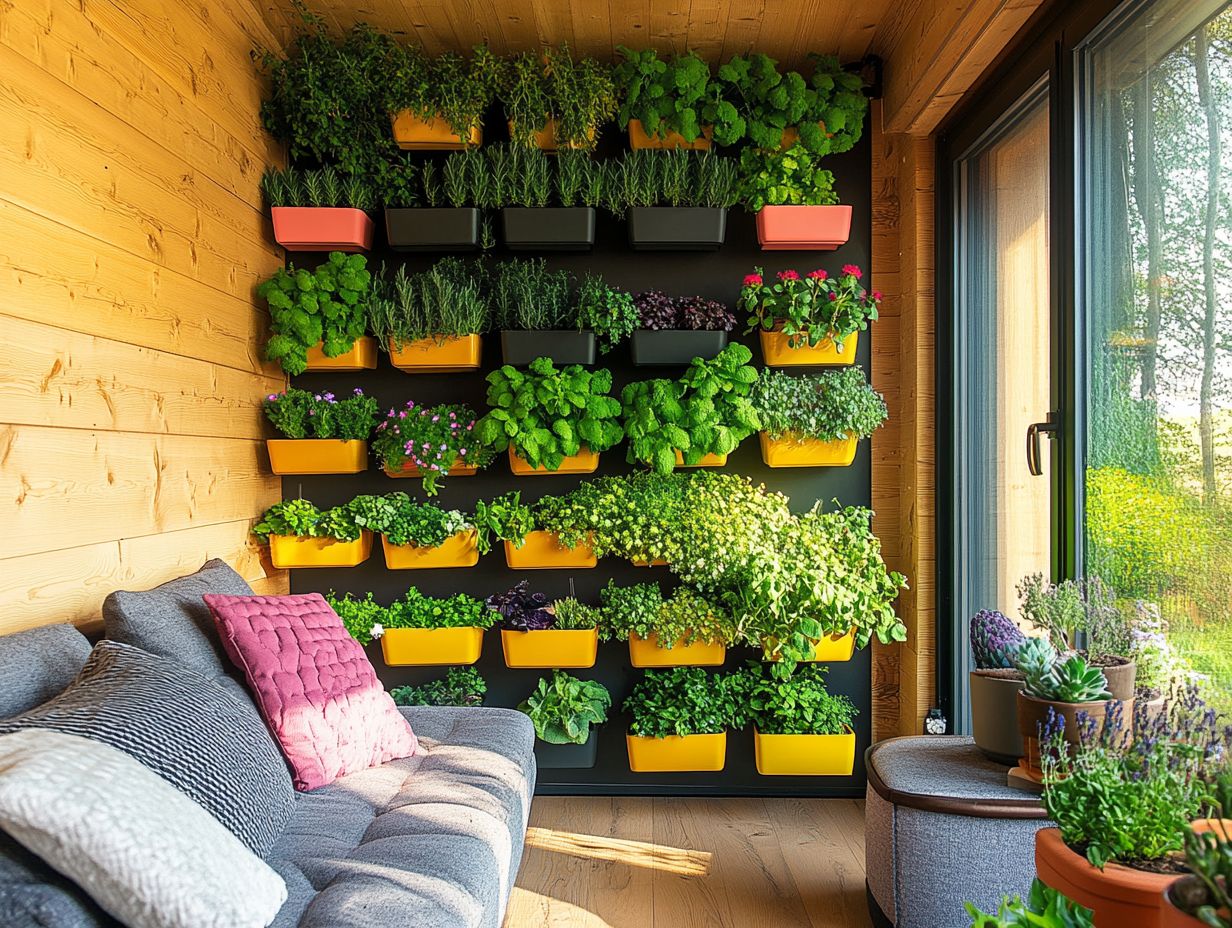
- Embrace vertical gardening in tiny homes by choosing the right plants that thrive in small spaces.
- Design a space-saving vertical garden using essential supplies and equipment, and maximize space by utilizing both indoor and outdoor areas.
- Maintain your vertical garden in a tiny home by regularly watering, pruning, and controlling pests to reap the benefits of a beautiful and functional green space.
Benefits and Challenges
Engaging in tiny home gardening offers a distinctive blend of benefits and challenges that can significantly enhance your living experience and promote sustainable living. You will love enjoying the satisfaction of growing your own eco-friendly food, while also benefiting from the space-saving solutions that container and vertical gardening provide.
One of the most delightful aspects of this venture is the direct access to fresh herbs and vegetables, which can elevate both the flavor and nutrition of your everyday meals. These compact garden spaces also foster community engagement, as neighbors often share tips, seeds, or even harvests, creating a wonderful sense of camaraderie.
Cultivating a pollinator-friendly garden not only contributes to local biodiversity but also brings joy as you watch colorful butterflies and bees frequent your blooms. Challenges include limited sunlight and poor soil quality, which can certainly slow your progress.
To navigate these hurdles, you’ll need to adopt effective techniques, such as selecting the right plant varieties, using raised beds for improved drainage, or incorporating organic fertilizers to ensure success in your green endeavors.
Choosing the Right Plants for Vertical Gardening
Selecting the right plants for your vertical garden is essential for unlocking the full potential of your compact home garden. This choice enables you to grow an impressive array of herbs, vegetables, and fruits, even in limited space.
By choosing plant varieties that flourish in vertical arrangements, you not only elevate the beauty of your gardening space but also ensure generous yields. Whether your focus is on kitchen gardening or creating a lively outdoor oasis, the right selections will make all the difference.
Types of Plants that Thrive in Small Spaces
In vertical gardening, you ll find that certain plants thrive beautifully in small spaces, including a delightful array of herbs, vegetables, and even microgreens. This opens up a wonderful opportunity for you to engage in homegrown food production.
Consider herbs like basil and cilantro; they re not just space-efficient but also pack a punch in flavor for your culinary masterpieces. When you integrate vegetables such as cherry tomatoes and peppers into your vertical garden, you maximize your yield while minimizing your footprint.
These plants naturally grow upwards, saving precious ground space. Using vertical plant stands or wall gardens will help you organize your crops with finesse, ensuring they receive ample sunlight, air circulation, and moisture.
This approach elevates your garden s growth potential while adding an aesthetically pleasing green element to your space, enabling you to cultivate a thriving garden even within the confines of limited square footage.
Start your vertical garden today and transform your living space!
Designing a Vertical Garden for Your Tiny Home
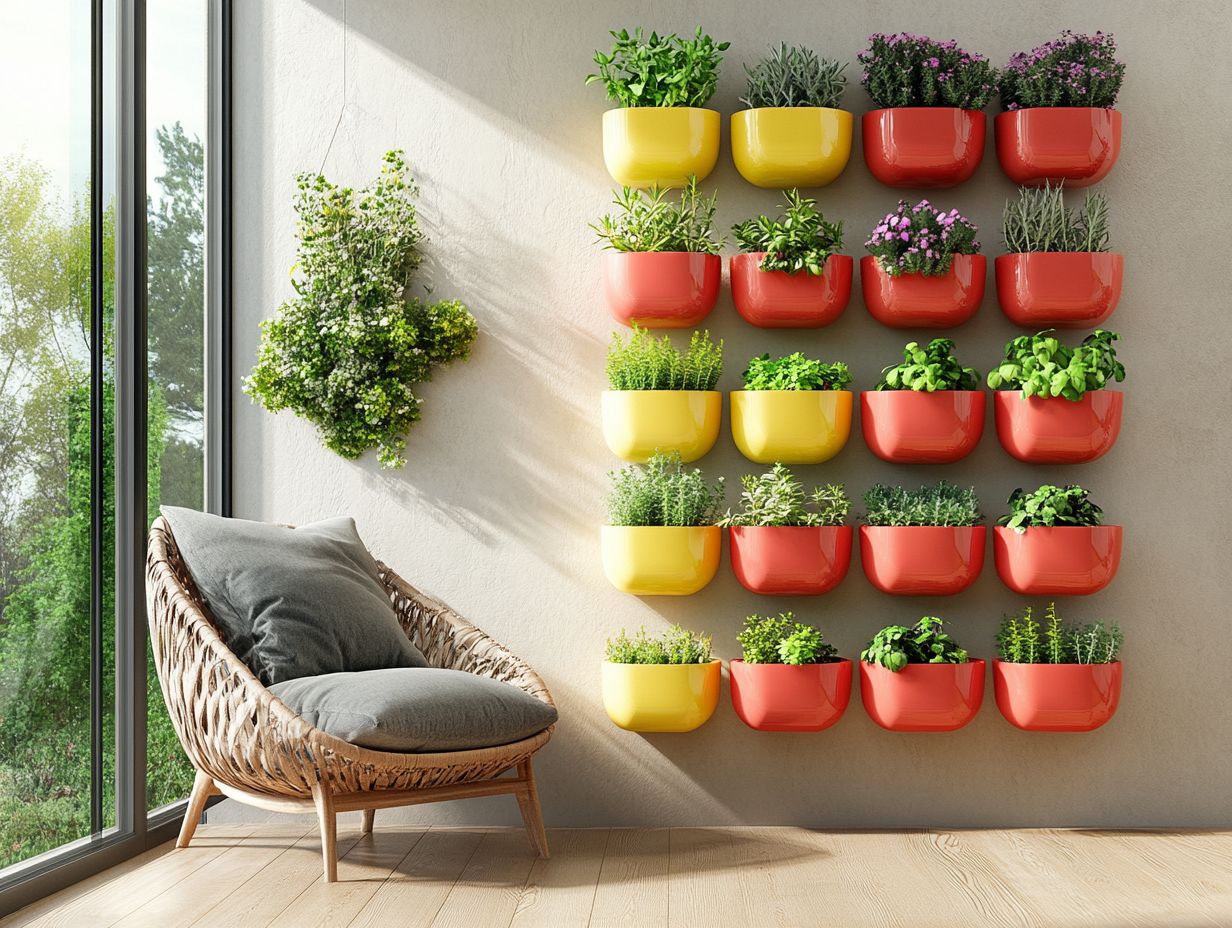
Designing a vertical garden for your tiny home makes the best use of small spaces and adds beauty.
By embracing innovative gardening concepts like DIY vertical gardens and living walls, you can transform neglected corners into lively spaces today, enriching your living environment and enhancing your gardening journey.
Space-Saving Techniques and Ideas
Implementing effective space-saving techniques is crucial for your successful vertical gardening journey in tiny homes. These techniques allow you to maximize your growing potential even within limited areas.
Creative ideas, such as utilizing wall-mounted planters or multi-functional furniture, provide innovative solutions for maintaining a diverse and productive garden despite the constraints of your living space.
Incorporating vertical plant stands elegantly showcases your favorite herbs and flowers while freeing up valuable floor space. Hanging plants from hooks or creating railing gardens adds a vibrant, green canopy that elevates the aesthetic of your tiny abode. For more ideas on enhancing your space, consider maximizing small outdoor areas in tiny living.
Even a small outdoor area can be transformed into a lush retreat. Innovative resources like aquaponics systems, which combine fish farming and plant cultivation, and self-watering planters enhance your gardening experience. These options ensure that busy individuals can savor the fruits of their labor without compromising on quality or care.
Materials and Tools Needed for Vertical Gardening
To successfully embark on vertical gardening in your tiny home, it’s essential to gather the right materials and tools that will support various gardening techniques and ensure healthy plant growth.
Investing in essential supplies like vertical plant stands, high-quality soil, and efficient irrigation systems will elevate your gardening experience and create an ideal environment for your plants to flourish.
Must-Have Supplies for Vertical Gardening
- Premium soil
- Top-tier fertilization options
- Effective watering systems
- Pots in various sizes
- Watering cans for precise hydration
- Hydroponics systems for innovative nutrient delivery
- Pruning tools to manage growth and ensure air circulation
- Pest control tools to maintain a vibrant and productive garden
Equipping yourself with the right tools is vital; they help manage plant growth and promote healthier development. Don’t forget pest control tools they’re essential to fend off any potential threats, keeping your vertical garden vibrant throughout the changing seasons.
Tips for Maintaining a Vertical Garden in a Tiny Home
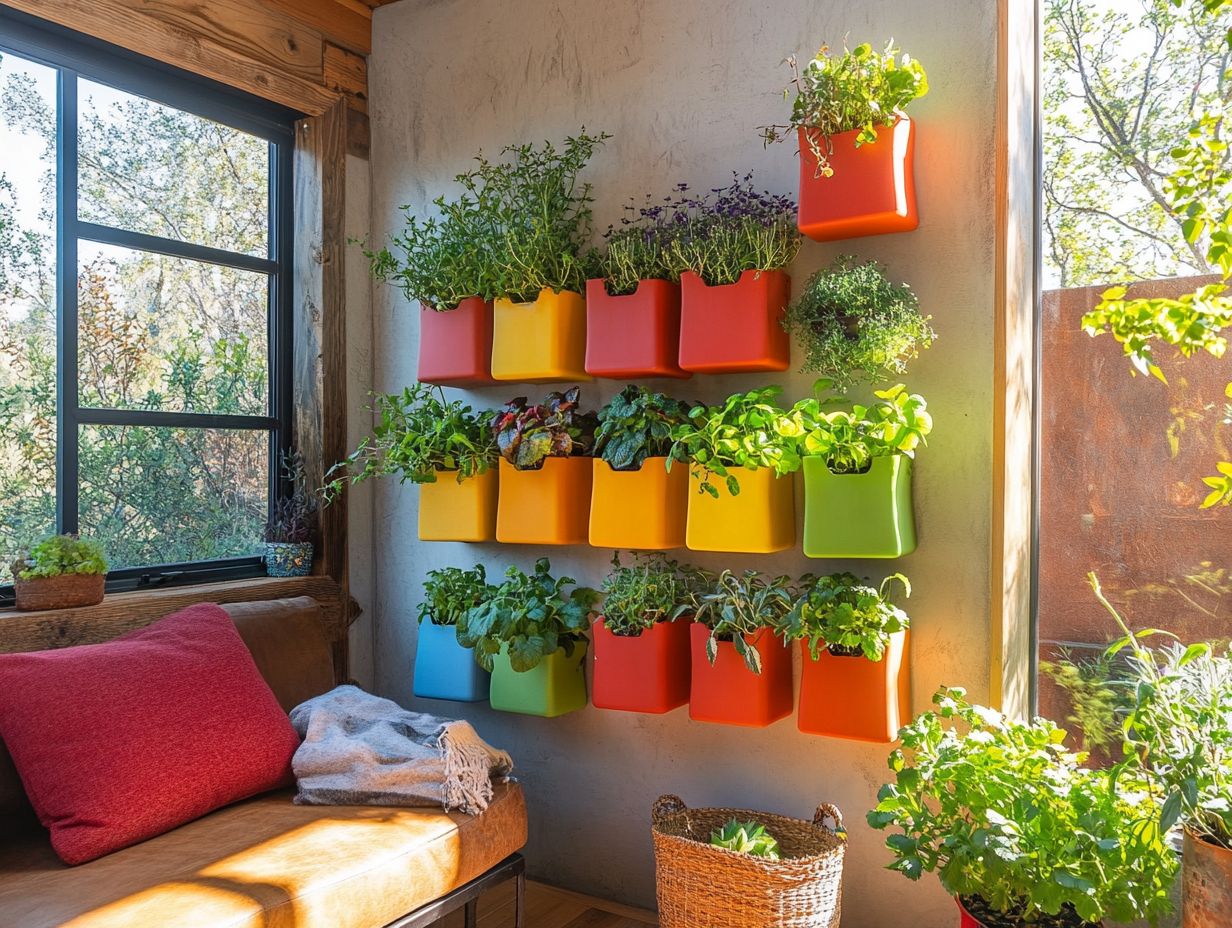
To cultivate a vertical garden in your tiny home, you’ll need a tailored approach that emphasizes watering, pruning, and pest control to keep your plants thriving and productive.
By adopting effective gardening techniques, you can foster a vibrant environment that nurtures the growth of your herbs, vegetables, and flowers, all while maximizing your limited space.
Start your vertical garden journey now!
Watering, Pruning, and Pest Control
Watering, pruning, and pest control are essential for successful plant maintenance in vertical gardening. These practices ensure your plants flourish in a compact living space.
By implementing these vital strategies, you can manage your garden more effectively, leading to improved growth outcomes and healthier plants.
To truly maximize your results, consider installing drip irrigation systems. This will ensure your plants receive consistent moisture, providing just the right amount without the risk of overwatering.
For pruning, always use sharp, clean shears. This promotes healthy growth and allows you to remove any dead or overcrowded foliage, enhancing airflow and light penetration.
For a more natural approach to pest control, consider integrating companion planting and introducing beneficial insects like ladybugs. These tiny helpers can keep harmful pests at bay.
Maintaining a balanced ecosystem within your vertical garden supports the health of each plant and creates a resilient environment where diverse species can coexist, offering both beauty and functionality.
Maximizing Space for Vertical Gardening in Tiny Homes
Maximizing space for vertical gardening in tiny homes is a smart approach that enables you to skillfully leverage both indoor and outdoor areas, crafting a lush and productive environment.
By embracing innovative small space solutions and urban gardening techniques, you can transform underutilized spots into vibrant gardens brimming with fresh herbs and vegetables. Additionally, making the most of vertical space in tiny houses enhances your lifestyle and improves your living conditions.
Utilizing Indoor and Outdoor Spaces
Utilizing both indoor and outdoor spaces for vertical gardening can truly enhance your gardening experience in a tiny home. It opens up a world of possibilities for cultivating a diverse array of plants.
Imagine your indoor vertical garden adorned with fragrant herbs like basil and mint, thriving in cozy, controlled conditions. Meanwhile, your outdoor setups can host larger vines like tomatoes or climbing beans, maximizing every inch of vertical space.
To create a seamless flow between these two areas, consider similar planting methods, such as hydroponics or aquaponics. Hydroponics is a method of growing plants without soil, while aquaponics combines fish farming with plant cultivation. These techniques can be adapted for both indoor and outdoor settings.
This approach fosters consistent care and helps maintain a unified aesthetic.
You ll find that your green spaces can harmonize beautifully, allowing you to relish your gardening passion, no matter where you are.
Frequently Asked Questions
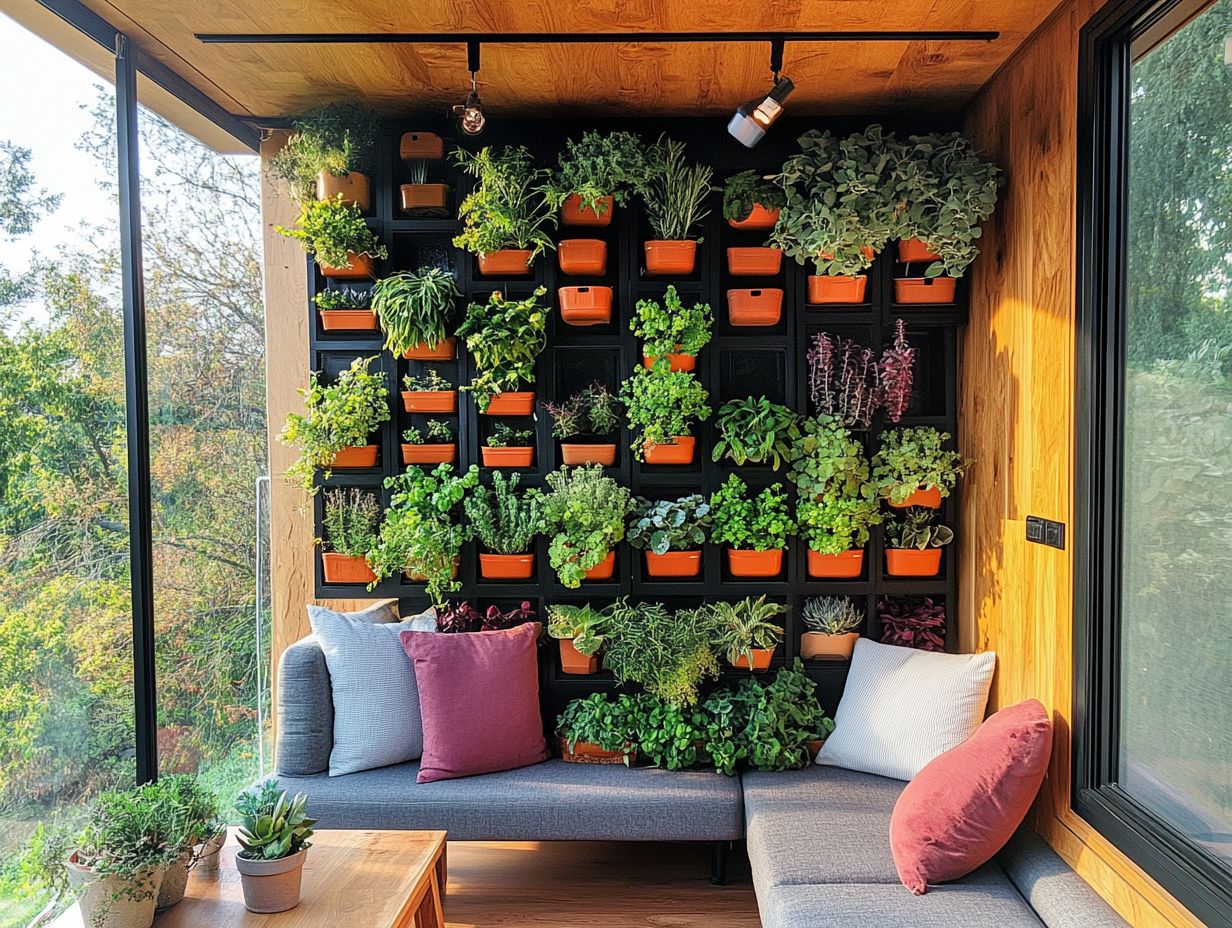
What is vertical gardening and how can it be incorporated into tiny homes?
Vertical gardening is a technique where plants grow upwards, typically on a vertical structure such as a wall or trellis, instead of horizontally in a traditional garden bed. It can be easily incorporated into tiny homes by utilizing vertical space.
What are the benefits of embracing vertical gardening in tiny homes?
Embracing vertical gardening in tiny homes allows for maximum use of limited space. It provides a unique and aesthetically pleasing way to incorporate indoor plants and can help purify indoor air.
What types of plants are best suited for vertical gardening in tiny homes?
Plants that are compact in size, have shallow root systems, and don’t require much space to grow are best suited for vertical gardening in tiny homes. Examples include herbs, succulents, and small vegetables like cherry tomatoes and peppers.
Do I need any special equipment to start vertical gardening in my tiny home?
While there are specialized products for vertical gardening, such as vertical planters and wall-mounted trellises, you can also use simple materials like hanging baskets, shelves, and repurposed containers to create your own mini garden in a tiny home.
How can I ensure my vertical garden in my tiny home is successful?
To have a thriving vertical garden in a tiny home, choose plants with similar light and watering needs. Provide proper drainage for your containers and keep a close eye on your plants for pests and diseases.
Are there any specific tips for maintaining a vertical garden in a tiny home?
Yes! Regularly prune and trim your plants to prevent overcrowding. This keeps them compact and healthy.
Don t forget to water and fertilize your plants regularly. Rotating them helps ensure even exposure to light, promoting better growth!

